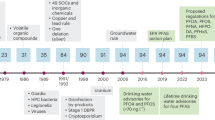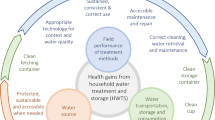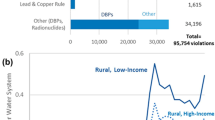Abstract
No other resource is as necessary for life as water, and providing it universally in a safe, reliable and affordable manner is one of the greatest challenges of the twenty-first century. Here, we consider new opportunities and approaches for the application of nanotechnology to enhance the efficiency and affordability of water treatment and wastewater reuse. Potential development and implementation barriers are discussed along with research needs to overcome them and enhance water security.
This is a preview of subscription content, access via your institution
Access options
Access Nature and 54 other Nature Portfolio journals
Get Nature+, our best-value online-access subscription
$29.99 / 30 days
cancel any time
Subscribe to this journal
Receive 12 print issues and online access
$259.00 per year
only $21.58 per issue
Buy this article
- Purchase on Springer Link
- Instant access to full article PDF
Prices may be subject to local taxes which are calculated during checkout




Similar content being viewed by others
References
Chen, B. et al. Global land-water nexus: Agricultural land and freshwater use embodied in worldwide supply chains. Sci. Total Environ. 613–614, 931–943 (2018).
Schewe, J. et al. Multimodel assessment of water scarcity under climate change. Proc. Natl Acad. Sci. USA 111, 3245–3250 (2014).
Coping with Water Scarcity - Challenge of the Twenty-First Century (UN Water, 2007).
Bates, B., Kundzewicz, Z., Wu, S. & Palutikof, J. (eds) Climate Change and Water Technical Paper of the Intergovernmental Panel on Climate Change (IPCC, 2008).
Steffen, W. et al. Planetary boundaries: Guiding human development on a changing planet. Science 347, 6223 (2105).
UNICEF & WHO. Progress on Sanitation and Drinking Water: 2015 Update and MDG Assessment (UNICEF, 2015).
Prüss‐Ustün, A. et al. Burden of disease from inadequate water, sanitation and hygiene in low‐ and middle‐income settings: a retrospective analysis of data from 145 countries. Trop. Med. Int. Health 19, 894–905 (2014).
Liu, L. et al. Global, regional, and national causes of child mortality: an updated systematic analysis for 2010 with time trends since 2000. Lancet 379, 2151–2161 (2012).
Luo, Y. et al. Proliferation of multidrug-resistant New Delhi metallo-β-lactamase genes in municipal wastewater treatment plants in northern China. Environ. Sci. Technol. Lett. 1, 26–30 (2014).
O’Neill. J. Antimicrobial Resistance: Tackling a Crisis for the Health and Wealth of Nations (The Review on Antimicrobial Resistance, 2014).
Hutton, G. & Haller, L. Evaluation of the Costs and Benefits of Water and Sanitation Improvements at the Global Level (WHO, 2004).
Van Minh, H. & Hung, N. V. Economic aspects of sanitation in developing countries. Environ. Health Insights 5, S8199 (2011).
Bigas, H. Water Security and the Global Water Agenda: A UN-water Analytical Brief (United Nations University - Institute for Water, Environment and Health, 2013).
Zodrow, K. R. et al. Advanced materials, technologies, and complex systems analyses: Emerging opportunities to enhance urban water security. Environ. Sci. Technol. 51, 10274–10281 (2017).
Dong, S. Y. et al. Recent developments in heterogeneous photocatalytic water treatment using visible light-responsive photocatalysts: a review. RSC Adv. 5, 14610–14630 (2015).
Kumar, S. G. & Devi, L. G. Review on modified TiO2 photocatalysis under UV/visible light: Selected results and related mechanisms on interfacial charge carrier transfer dynamics. J. Phys. Chem. A 115, 13211–13241 (2011).
Zhang, D. S. et al. Enhanced capacitive deionization performance of graphene/carbon nanotube composites. J. Mater. Chem. 22, 14696–14704 (2012).
Wang, H. et al. In situ creating interconnected pores across 3D graphene architectures and their application as high performance electrodes for flow-through deionization capacitors. J. Mater. Chem. A 4, 4908–4919 (2016).
Yang, Y. & Hoffmann, M. R. Synthesis and stabilization of blue-black TiO2 nanotube arrays for electrochemical oxidant generation and wastewater treatment. Environ. Sci. Technol. 50, 11888–11894 (2016).
Liu, S. et al. Improved degradation of the aqueous flutriafol using a nanostructure macroporous PbO2 as reactive electrochemical membrane. Electrochim. Acta 253, 357–367 (2017).
Radjenovic, J. & Sedlak, D. L. Challenges and opportunities for electrochemical processes as next-generation technologies for the treatment of contaminated water. Environ. Sci. Technol. 49, 11292–11302 (2015).
Yavuz, C. T. et al. Low-field magnetic separation of monodisperse Fe3O4 nanocrystals. Science 314, 964–967 (2006).
Farrell, J. W. et al. Arsenic removal by nanoscale magnetite in Guanajuato, Mexico. Environ. Eng. Sci. 31, 393–402 (2014).
Cooper, A. M., Hristovski, K. D., Moller, T., Westerhoff, P. & Sylvester, P. The effect of carbon type on arsenic and trichloroethylene removal capabilities of iron (hydr)oxide nanoparticle-impregnated granulated activated carbons. J. Hazard. Mater. 183, 381–388 (2010).
Sylvester, P., Westerhoff, P., Mooller, T., Badruzzaman, M. & Boyd, O. A hybrid sorbent utilizing nanoparticles of hydrous iron oxide for arsenic removal from drinking water. Environ. Eng. Sci. 24, 104–112 (2007).
Alsbaiee, A. et al. Rapid removal of organic micropollutants from water by a porous β-cyclodextrin polymer. Nature 529, 190–194 (2015).
Mauter, M. S. et al. The role of nanotechnology in tackling global water challenges. Nat. Sustain. 1, 166–175 (2018).
Lee, J. et al. Photochemical and antimicrobial properties of novel C60 derivatives in aqueous systems. Environ. Sci. Technol. 43, 6604–6610 (2009).
Lee, J. et al. C60 aminofullerene immobilized on silica as a visible-light-activated photocatalyst. Environ. Sci. Technol. 44, 9488–9495 (2010).
Lee, C.-G. et al. Porous electrospun fibers embedding TiO2 for adsorption and photocatalytic degradation of water pollutants. Environ. Sci. Technol. 52, 4285–4293 (2018).
Wang, F. Hollow anatase TiO2 octahedrons with exposed high-index {102} facets for improved dye-sensitized photoredox catalysis activity. Inorg. Chem. 57, 4550–4555 (2018).
Liu, S., Yu, J. & Jaroniec, M. Tunable photocatalytic selectivity of hollow TiO2 microspheres composed of anatase polyhedra with exposed {001} facets. J. Am. Chem. Soc. 132, 11914–11916 (2010).
Zhang, R. et al. Antifouling membranes for sustainable water purification: strategies and mechanisms. Chem. Soc. Rev. 45, 5888–5924 (2016).
Boo, C., Lee, J. & Elimelech, M. Engineering surface energy and nanostructure of microporous films for expanded membrane distillation applications. Environ. Sci. Technol. 50, 8112–8119 (2016).
Yamani, J. S., Lounsbury, A. W. & Zimmerman, J. B. Towards a selective adsorbent for arsenate and selenite in the presence of phosphate: Assessment of adsorption efficiency, mechanism, and binary separation factors of the chitosan-copper complex. Water Res. 88, 889–896 (2016).
Dongare, P. D. et al. Nanophotonics-enabled solar membrane distillation for off-grid water purification. Proc. Natl Acad. Sci. USA 114, 6936–6941 (2017).
Zodrow, K. et al. Polysulfone ultrafiltration membranes impregnated with silver nanoparticles show improved biofouling resistance and virus removal. Water Res. 43, 715–723 (2009).
Tang, W., He, D., Zhang, C. & Waite, T. D. Optimization of sulfate removal from brackish water by membrane capacitive deionization (MCDI). Water Res. 121, 302–310 (2017).
Yu, C. Modulating particle adhesion with micro-patterned surfaces. ACS Appl. Mater. Inter. 6, 8199–8207 (2014).
Werber, J. R., Osuji, C. O. & Elimelech, M. Materials for next-generation desalination and water purification membranes. Nat. Rev. Mater. 1, 16018 (2016).
Liu, C., Lee, J., Small, C., Ma, J. & Elimelech, M. Comparison of organic fouling resistance of thin-film composite membranes modified by hydrophilic silica nanoparticles and zwitterionic polymer brushes. J. Memb. Sci. 544, 135–142 (2017).
Ben-Sasson, M., Lu, X., Nejati, S., Jaramillo, H. & Elimelech, M. In situ surface functionalization of reverse osmosis membranes with biocidal copper nanoparticles. Desalination 388, 1–8 (2016).
Ben-Sasson, M. et al. In situ formation of silver nanoparticles on thin-film composite reverse osmosis membranes for biofouling mitigation. Water Res. 62, 260–270 (2014).
Lu, X. et al. Enhanced antibacterial activity through the controlled alignment of graphene oxide nanosheets. Proc. Natl Acad. Sci. USA 114, E9793–E9801 (2017).
Perreault, F., de Faria, A. F., Nejati, S. & Elimelech, M. Antimicrobial properties of graphene oxide nanosheets: Why size matters. ACS Nano 9, 7226–7236 (2015).
Perreault, F. et al. Biofouling mitigation in forward osmosis using graphene oxide functionalized thin-film composite membranes. Environ. Sci. Technol. 50, 5840–5848 (2016).
Faria, A. F. et al. Thin-film composite forward osmosis membranes functionalized with graphene oxide–silver nanocomposites for biofouling control. J. Memb. Sci. 525, 146–156 (2017).
Park, H. B., Kamcev, J., Robeson, L. M., Elimelech, M. & Freeman, B. D. Maximizing the right stuff: The trade-off between membrane permeability and selectivity. Science 356, eaab0530 (2017).
Werber, J. R., Deshmukh, A. & Elimelech, M. The critical need for increased selectivity, not increased water permeability, for desalination membranes. Environ. Sci. Technol. Lett. 3, 112–120 (2016).
Brame, J., Long, M. C., Li, Q. L. & Alvarez, P. Trading oxidation power for efficiency: Differential inhibition of photo-generated hydroxyl radicals versus singlet oxygen. Water Res. 60, 259–266 (2014).
Chong, M. N., Jin, B., Chow, C. W. K. & Saint, C. Recent developments in photocatalytic water treatment technology: A review. Water Res. 44, 2997–3027 (2010).
Lee, H. & Choi, W. Photocatalytic oxidation of arsenite in TiO2 suspension: Kinetics and mechanisms. Environ. Sci. Technol. 36, 3872–3878 (2002).
Tan, T. T. Y., Beydoun, D. & Amal, R. Photocatalytic reduction of Se(VI) in aqueous solutions in UV/TiO2 system: Importance of optimum ratio of reactants on TiO2 surface. J. Mol. Catal. A Chem. 202, 73–85 (2003).
Chenthamarakshan, C. R. & Rajeshwar, K. Heterogeneous photocatalytic reduction of Cr(VI) in UV-irradiated titania suspensions: Effect of protons, ammonium ions, and other interfacial aspects. Langmuir 16, 2715–2721 (2000).
Doudrick, K., Monzon, O., Mangonon, A., Hristovski, K. & Westerhoff, P. Nitrate reduction in water wsing commercial titanium dioxide photocatalysts (P25, P90, and Hombikat UV100). J. Environ. Eng. 138, 852–861 (2012).
Li, L. L. et al. Enhanced biofilm penetration for microbial control by polyvalent phages conjugated with magnetic colloidal nanoparticle clusters (CNCs). Environ. Sci. Nano 4, 1817–1826 (2017).
Jabbari, V., Veleta, J. M., Zarei-Chaleshtori, M., Gardea-Torresdey, J. & Villagran, D. Green synthesis of magnetic MOF@GO and MOF@CNT hybrid nanocomposites with high adsorption capacity towards organic pollutants. Chem. Eng. J. 304, 774–783 (2016).
Fu, Y., Wang, J. Y., Liu, Q. X. & Zeng, H. B. Water-dispersible magnetic nanoparticle-graphene oxide composites for selenium removal. Carbon 77, 710–721 (2014).
Su, H., Ye, Z. B., Hmidi, N. & Subramanian, R. Carbon nanosphere-iron oxide nanocomposites as high-capacity adsorbents for arsenic removal. RSC Adv. 7, 36138–36148 (2017).
Bagbi, Y., Sarswat, A., Mohan, D., Pandey, A. & Solanki, P. R. Lead and chromium adsorption from water using L-cysteine functionalized magnetite (Fe3O4) nanoparticles. Sci. Rep. 7, 7672 (2017).
Neumann, O. et al. Solar vapor generation enabled by nanoparticles. ACS Nano 7, 42–49 (2013).
Hogan, N. J. et al. Nanoparticles heat through light localization. Nano Lett. 14, 4640–4645 (2014).
Ghasemi, H. et al. Solar steam generation by heat localization. Nat. Commun. 5, 4449 (2014).
Zhou, L. et al. 3D self-assembly of aluminium nanoparticles for plasmon-enhanced solar desalination. Nat. Photon. 10, 393–398 (2016).
Kashyap, V. et al. A flexible anti-clogging graphite film for scalable solar desalination by heat localization. J. Mater. Chem. A 5, 15227–15234 (2017).
Dongare, P. D. et al. Nanophotonics-enabled solar membrane distillation for off-grid water purification. Proc. Natl Acad. Sci. USA 114, 6936–6941 (2017).
Hua, M. et al. Heavy metal removal from water/wastewater by nanosized metal oxides: A review. J. Hazard. Mater. 211, 317–331 (2012).
Torrent, J., Barron, V. & Schwertmann, U. Phosphate adsorption and desorption by goethites differing in crystal morphology. Soil Sci. Soc. Am. J. 54, 1007–1012 (1990).
Waychunas, G. A., Kim, C. S. & Banfield, J. F. Nanoparticulate iron oxide minerals in soils and sediments: unique properties and contaminant scavenging mechanisms. J. Nanopart. Res. 7, 409–433 (2005).
Lounsbury, A. W., Yamani, J. S., Johnston, C. P., Larese-Casanova, P. & Zimmerman, J. B. The role of counter ions in nano-hematite synthesis: Implications for surface area and selenium adsorption capacity. J. Hazard. Mater. 310, 117–124 (2016).
Chen, X. B., Liu, L., Yu, P. Y. & Mao, S. S. Increasing solar absorption for photocatalysis with black hydrogenated titanium dioxide nanocrystals. Science 331, 746–750 (2011).
Swearer, D. F. et al. Heterometallic antenna-reactor complexes for photocatalysis. Proc. Natl Acad. Sci. USA 113, 8916–8920 (2016).
Acknowledgements
This work was supported by the National Science Foundation Engineering Research Center on Nanotechnology-Enabled Water Treatment (EEC-1449500).
Author information
Authors and Affiliations
Corresponding author
Ethics declarations
Competing interests
The authors declare no competing interests.
Additional information
Publisher’s note: Springer Nature remains neutral with regard to jurisdictional claims in published maps and institutional affiliations.
Rights and permissions
About this article
Cite this article
Alvarez, P.J.J., Chan, C.K., Elimelech, M. et al. Emerging opportunities for nanotechnology to enhance water security. Nature Nanotech 13, 634–641 (2018). https://doi.org/10.1038/s41565-018-0203-2
Received:
Revised:
Accepted:
Published:
Issue Date:
DOI: https://doi.org/10.1038/s41565-018-0203-2
This article is cited by
-
Advancement in nanomaterials for environmental pollutants remediation: a systematic review on bibliometrics analysis, material types, synthesis pathways, and related mechanisms
Journal of Nanobiotechnology (2024)
-
Regulating ion affinity and dehydration of metal-organic framework sub-nanochannels for high-precision ion separation
Nature Communications (2024)
-
Wood-inspired metamaterial catalyst for robust and high-throughput water purification
Nature Communications (2024)
-
Walking-induced electrostatic charges enable in situ electroporated disinfection in portable water bottles
Nature Water (2024)
-
Mechanism of Cr(VI) removal by polyphenols-rich bacterial cellulose gel produced from fermented wine pomace
npj Clean Water (2024)



